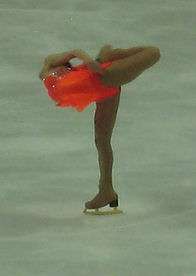Camel spin
| Figure skating element | |
|---|---|
 | |
| Element name: | Camel spin |
| Alternative name: | Parallel spin |
| Scoring abbreviation: | CSp |
| Element type: | Spin |
A camel spin, also known in Europe as a parallel spin, is one of the three basic figure skating spins, along with the sit spin and upright spin. The basic camel spin position is defined as one in which the free leg is extended backwards with the knee held above hip level.[1]
History
Most sources credit the invention of the camel spin to British skater Cecilia Colledge, who first performed it successfully in competition in 1935.[2] Like the layback spin, also invented by Colledge, the camel was originally considered a move for women only.
The origin of the spin's name is disputed. Most authorities believe that the name originated when a skater performed the spin with her upper body and free leg drooping down, giving the illusion of a hunched camel. According to figure skating coach Gustave Lussi, the spin was invented not by Cecilia Colledge but by an Australian skater named Campbell, thus explaining that "Campbell spin" became afflicted into "camel spin".
The Grafström spin may predate the invention of the "regular" camel spin. Although it is named after Gillis Grafström, its best practitioner is said to be Czechoslovakian skater Otto Gold, who won the silver medal at the 1930 European Figure Skating Championships.
Dick Button is credited with inventing the flying camel spin in the 1940s. It was originally known as the Button camel.
The "illusion spin" was accidentally invented by Jacqueline du Bief when she lost control on the entrance to a camel spin.
Several female pair skaters have suffered head/face injuries after their partners accidentally drifted too close during side-by-side camel spins – Elena Berezhnaya, Jessica Dubé, Mandy Wötzel, and Galina Maniachenko.
Variations
- Flying camel spin – formerly known as a Button camel, initiated with a jump from a forward outside edge to a back camel spin.
- Layover – performed by upturning the torso and free leg so that the skater's torso and free foot are pointing toward the ceiling, rather than toward the ice. This spin is frequently seen in artistic roller skating, where it is called a "layback spin" (but is distinct from the layback spin performed on ice).
- Bent-leg layover – similar to a layover, except with a bent free leg. Josée Chouinard[3] and Kim Yuna are among the best-known practitioners of this spin variation. Both have used it as one of their signature moves.
- Catch-foot camel – performed by the skater grasping the free leg's blade with either hand. The skater's torso remains pointed toward the ice, and the free leg is held upward. A catch-foot camel with free leg extended upwards is sometimes called a one-hand Biellman or a half-Biellmann—named for Swiss skater Denise Biellmann, who popularized the move in the 1970s and '80s.
- Doughnut or donut spin – a catch-foot camel, but the skater's head is pulled toward the free leg's foot so that the skater's head, torso, and free leg form a toric shape parallel to the ice. Oksana Baiul, Yukari Nakano frequently perform this spin.[4]
- Grafström spin – camel with a bent skating leg, with the free foot still in the arabesque position.
- Hamill camel – not a true camel per se, but rather a transition from a backwards camel to a backwards sit spin by bending the skating leg and dropping the torso and free leg simultaneously.
- Illusion spin – performed by the skater keeping their head, torso, and free leg in a straight line, and rhythmically bobbing above and below the position of a standard camel spin. Tiffany Chin performed this spin frequently as an amateur.
- Forward Camel with change of edge – this spin starts off as a regular camel spin. Then the skater changes back to a forward outside edge and continues to spin in small forward outside circles and then switches back to a regular camel spin. This move requires a lot of control and power.
Gallery
In single skating
 A basic camel spin
A basic camel spin
(Emily Hughes)- A basic camel spin
(Tomáš Verner)  Bent-leg layover spin
Bent-leg layover spin
(Kim Yuna) Catch-foot camel spin
Catch-foot camel spin
(Jamal Othman) Donut spin (front view)
Donut spin (front view)
(Yukari Nakano) Donut spin (back view)
Donut spin (back view)
(Shizuka Arakawa) Flying camel spin midair (butterfly)
Flying camel spin midair (butterfly)
(Alissa Czisny)
In pairs and ice dancing
In synchronized skating
 Four synchronized skaters perform camel spins
Four synchronized skaters perform camel spins
References
- ↑ "ISU Communication No. 1445".
- ↑ http://figureskating.about.com/od/glossaryofskatingterms/g/camel.htm Jo Ann Schneider Farris - Camel Spin, Accessed on June 27, 2014
- ↑ Beverley Smith, Figure Skating: A Celebration, ISBN 0-7710-2819-9, page 252
- ↑ Nakano still determined to achieve more on the ice 2007-11-23, Icenetwork.com
- Figure Skating: Championship Techniques. John Misha Petkevich, 1989. ISBN 0-452-26209-7.
- Systematic Figure Skating: The Spin & Jump Techniques of Gustave Lussi. (instructional videos)
- Single Figure Skating. Josef Dĕdič, 1974.
- Dick Button on Skates. Dick Button, 1955.
| Wikimedia Commons has media related to Camel spins. |


